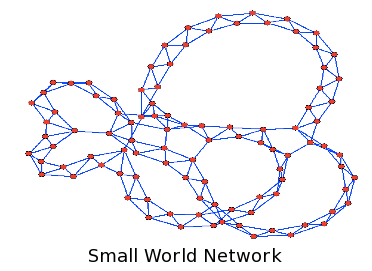Social Network Structures of Twitter, Facebook and Google +
Social Network Structures of Twitter, Facebook and Google + and their Impacts on Information Flow!
There has been a ton of hype lately over Google+ and how it is going to kill Twitter or Facebook or both. I wanted to take a minute to explore each of these and I would love your thoughts.

 People are all wound up comparing feature sets from one platform to another but there are some critical fundamentals we have to understand first about how information flows. Lets look at the network structure of all the three networks. All the three networks have a very different network structure. People on Twitter tend to connect with people they find have similar interest because of which Twitter has a network structure that is mainly tends towards being small world . Once you identify your network of interest the information can be percolated to the right people quickly. Whereas Facebook is a network where people connect to people they already know and share their likes and dislikes with them. It is very rare that one would connect with somebody they don t alreadyknow therefore the network structure acquires more of scale free structure. In both these networks preferential attachment (why people choose to connect with somebody)occurs but the reasons for preferential attachment are quite different leading to different network structures.
People are all wound up comparing feature sets from one platform to another but there are some critical fundamentals we have to understand first about how information flows. Lets look at the network structure of all the three networks. All the three networks have a very different network structure. People on Twitter tend to connect with people they find have similar interest because of which Twitter has a network structure that is mainly tends towards being small world . Once you identify your network of interest the information can be percolated to the right people quickly. Whereas Facebook is a network where people connect to people they already know and share their likes and dislikes with them. It is very rare that one would connect with somebody they don t alreadyknow therefore the network structure acquires more of scale free structure. In both these networks preferential attachment (why people choose to connect with somebody)occurs but the reasons for preferential attachment are quite different leading to different network structures.
The network structure has a huge impact on the how the information flows as a result changing what phenomenon s like influence mean. On Twitter people are influenced by the subject matter expert because the network structure supports the flow of expertise of an individual. A tweet on an interesting topic by a subject matter expert can reach people who are three to four degrees away from the expert and are not directly connected. This I believe is the reason why twitter is an effective place to run campaigns based on a subject.
Whereas people on Facebook are influenced by the likes and dislikes of the people they know and trust which is supported by the scale free network structure (I discussed these types of networks in my previous posts). The status update by an individual is interesting only to people in their first degree of network or at the most to a few in the second degree. That s why there is a need for a property like fanpage, where the intention is that if you trust a brand then people who trust you will also trust the brand. Therefore, Facebook really works well to keep people connected with the brand.
Coming back to Google+, It lets you segregate your network based on the concept of circles. What this means is that it effectively gives you an opportunity to connect with people who are interesting because of a subject (who you already know) and same time you can connect with people who are your personal friends. You can do all this on the same network while keeping these two groups separate all the time. The concept of circles lets you creates cliques (A) within you network and each clique can have a separate network structure (B). This has a huge impact on the underlying information flow and the reach of the network. It is very difficult for information to flow in this kind of a network structure. Formation of clique limits the exposure of information only to people in the circle thereby keeping the flow focused for an audience but at the same time limits the reach of information beyond the circle. But this provides Google with an opportunity to understand your interests (and do better ad targeting and improve search but does not necessarily mean you can find people with common interests, whom you don t already know.

There is another drawback too. Google + lets one manipulate with network structure by creating circles, unlike Twitter or Facebook where the network structure is organically created because of your interactions. What happens if you have few circles with too many people or too many circles with few people in each circle? In the first case you gain reach but lose focused audience in the second case you gain focused audience but loose reach. Attaining that right balance is difficult. As these networks are dynamic networks the right mix may be a moving target which creates more hassle than it s worth if not managed properly.
These are the things I think about when looking at these networks. What do you think?
